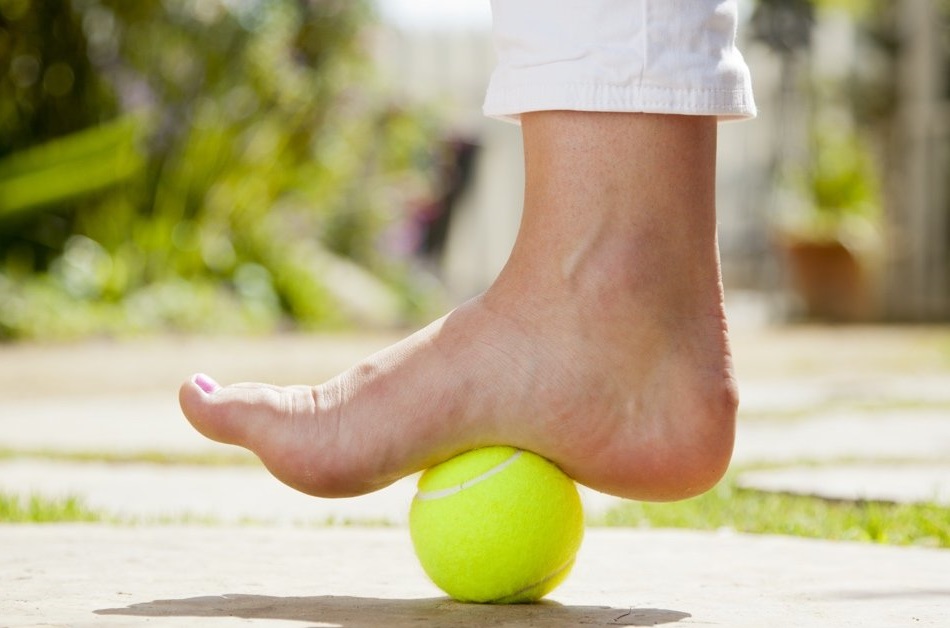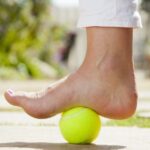It can feel like a full-time job managing plantar fasciitis pain. You know, that torturous ache in the undersides of your feet that you feel when you walk? But when you spend most of the hours of your day at an actual full-time job, working in time for pain relief can be challenging.
Fortunately, many treatments can effectively relieve the pain of plantar fasciitis. Best of all, many of them are quick and easy to do without peers and coworkers noticing. You can do them at your desk, on your lunch break, or whenever you get a few minutes.
Try these 13 simple plantar fasciitis pain treatments for fast relief…
Stretch

Stretching, which can be done anywhere, is a simple way to improve the strength and flexibility of the plantar fascia ligament, making it an effective way to relieve plantar fasciitis pain and promote healing.
Incorporating a wall, some stairs, a belt, and basic furniture items, there are various types of stretches that one can do easily to reduce, heal pain fast, and strengthen the plantar fascia.
Massage

Alleviate pain in your heels and soothe aching muscles by performing basic massage techniques using your fingers. You can even do this at your desk; coworkers will be none the wiser.
For fast relief from plantar fasciitis pain, simply massage your heels and arches using your thumbs with moderate pressure. Start from the balls of your feet and work your way up to the heels.
Ice the Pain

Applying ice to the foot is an excellent way to reduce inflammation and relieve pain from heel spurs and plantar fasciitis. It’s a practical method, too, and doesn’t have to be messy.
Cover an ice pack with a thin towel or cloth and hold it over the affected area for about 15 minutes. Or, invest in a pair of ice-pack slippers and slip them on whenever you have a short break.
Get a Ball Rolling

Keep a tennis ball or golf ball in your desk drawer or purse. Whenever you’re experiencing plantar fasciitis pain, rest your foot on the ball, hang on to something stable, and roll the ball under your arches.
This DIY treatment gets the blood flowing to the arches and heels and works to repair plantar fascia ligament tears that haven’t healed properly. The exercise can be done in a sitting or standing position.
Roll a Water Bottle

Don’t have a tennis ball or golf ball? Not a problem. Use a water bottle to relieve your plantar fasciitis pain. If you don’t have one at your desk, then you can probably find one in the workplace break room.
Like the ball exercise, this method requires resting your feet on the bottle (filled with water), which you will roll between the balls and heels. For added relief, freeze the bottle before use.
Stand on a Book

If you have a thick, sturdy book lying around like an encyclopedia or dictionary, then you can use it to increase the strength of the muscles and ligaments in your feet and reduce plantar fasciitis pain.
Begin by stepping onto the book placed a couple of feet from a wall, allowing your heels to hang off the back edge. Then, lean against the wall, hold the pose for 10-15 seconds, and lift your feet up and down.
Pull a Washcloth

When you’re experiencing pain from plantar fasciitis, pulling on a washcloth with your toes can provide rapid relief. It also offers the long-term benefit of strengthening and building weak foot muscles.
The exercise is simple. Sit on a chair, lay an old washcloth at your feet, and plant your heels. Then, attempt to pull the cloth using just your toes until you find it positioned under your feet.
Dry Cup

Dry cupping is a method of relieving plantar fasciitis pain that some people find unusual. Nevertheless, it is effective and can be done in minutes without difficulty using a commercial cupping kit.
A cup is placed on the skin in certain positions with dry cupping to produce a vacuum that increases blood flow to targeted areas. The result is less pain and broken-up plantar fasciitis adhesions.
Try TENS Therapy

TENS (Transcutaneous Electrical Nerve Stimulation) therapy delivers small electrical currents to the nerves of the feet, intending to interrupt pain signals and improve circulation.
There are different types of TENS devices. They come in the form of a sandal that you can slip onto your feet discreetly. They’re also available as a cellphone-like unit with attachable electrodes.
Cushion Your Shoes

Placing orthotic inserts in your shoes can go a long way in reducing plantar fascia pain. In fact, you can find inserts called Heel Seats, made specifically to relieve plantar fasciitis.
Heel Seats can be purchased online and at pharmacies, or you can have orthotic inserts custom-made for your feet. Just slip them into your shoes for an instant comfort boost and ongoing pain relief.
Rest

In some cases, pain from plantar fasciitis is simply your body’s way of telling you that your feet need a rest, particularly if you are constantly on your feet at work and in your spare time.
To reduce inflammation and pain, take regular sit-down breaks and put your feet up when possible. That is if you have a job that allows it. The same applies after hours.
Separate Your Toes

When you rest, wear a toe separator. Toe separators encourage curled toes to uncurl to a normal position by elongating short, tight tendons. They also promote healthy blood flow, providing fast pain relief.
Toe separators offer short-term and long-term benefits. They can be purchased online and in drugstores and pharmacies. Alternatively, you can make your own using sponges or other small objects.
Pop an Antiinflammatory

Nonsteroidal anti-inflammatory drugs (NSAIDs) like ibuprofen (Motrin, Advil, etc.) reduce inflammation in the body. This can help alleviate foot pain resulting from inflamed plantar fascia.
While NSAIDs can provide quick relief when you experience plantar fasciitis pain, it’s important not to take more than recommended. Also, these drugs are known to interact with certain medications.







